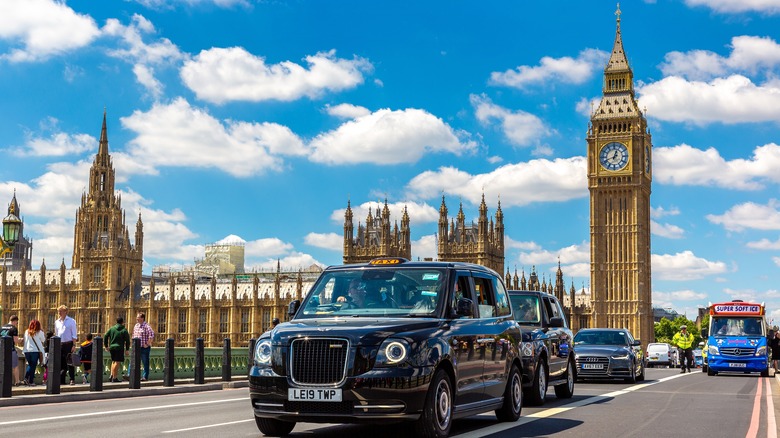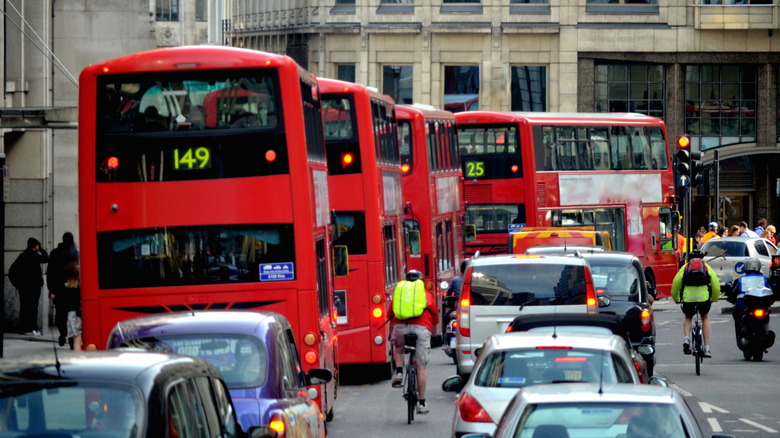The Unexpected And Pricey Reason Tourists Should Avoid Driving In London, Per Rick Steves
Driving abroad is always an adventure. You have to get your head around different road signs, markings, and traffic regulations, often on the fly, while dealing with varying attitudes to rules and safety. In Europe, the locals' driving styles can be hair-raising to say the least, from the chaotic machismo in some countries to the vehicular mayhem of Greece's roads; the country was voted as having the worst drivers on the continent in 2022. You might think that driving in London, the capital of a country traditionally known for good manners and law-abiding citizens, is a safer bet, but it comes at a cost. Like everything else in the city, driving in central areas can be pricey thanks to the congestion charge.
The ever-optimistic Rick Steves (per his website) thinks that driving in Britain is wonderful, although you must get used to the other side of the road. But even Steves acknowledges that it isn't the same joy for everyone and visitors should refrain from venturing into the cities by car. That should go double for London; not only is the capital notorious for some of the worst traffic in the world and 20 mph speed limits that make it one of the slowest drives on the planet, but you also have to pay for the privilege. Once you experience this combination of factors first-hand, you'll see why many British people consider driving in the Big Smoke "impossible" or a "nightmare," and one that Londoners often avoid altogether.
What is the congestion charge and how does it work?
The London congestion charge was introduced in 2003 to cover several areas of Central London. The goal was to reduce traffic and encourage commuters to use buses and the London Underground instead, raising money to spend on improving public transport. That was all well and good on paper, but the levy has proven controversial over the years. Critics claim it impacts businesses, unfairly penalizes lower-income drivers, and increases traffic outside the zone as drivers try to avoid the fee.
The charge is a fixed daily amount that applies during certain hours. It has gone up since Rick Steves alerted visitors on his website; as of 2024, the charge was £15 ($19) per day if paid in advance or on the day of travel, rising to £17.50 ($22) until midnight on the third day after your journey. Failure to pay incurs a penalty charge notice (PCN). That will cost you £180 ($228), with a 50% discount if you settle up within 14 days. The penalty rises to £270 ($242) if you fail to pay within 28 days.
Visitors with disabilities are exempt from the fee, as are electric cars (until 2025). The charge is monitored automatically by cameras set up across the zone to read license plates. Overall, it isn't too bad if you are only visiting London for a day or two, but it can soon stack up if you are driving in the capital for longer periods.
Better alternatives to driving in London
Many drivers automatically think that renting a car on their travels is the most convenient way to go, but that isn't always the case in London. Aside from the congestion charge, London traffic is infuriating by almost anyone's standards, and driving across the city can be a joyless slog. That's all before you try to find somewhere to park the car.
It's less of a headache to enter into the spirit of why the charge was partially introduced in the first place and opt for public transport. The London Underground can be claustrophobic and hectic at peak times, but the Tube will take you just about anywhere you need to go. Alternatively, the London bus network is extensive and has an added benefit — while the famous double-deckers can sometimes get snarled up in traffic, they are a great way to take a cheap sightseeing tour of the city.
Another option is just taking a stroll. Greater London is vast, but most of the attractions you won't want to miss are located in the relatively compact and walkable central boroughs. There is always plenty to see, and you're never far from somewhere to sit and grab some refreshments if your feet get a bit sore. In some cases, traveling on foot can be even quicker than taking a bus or the Tube.


